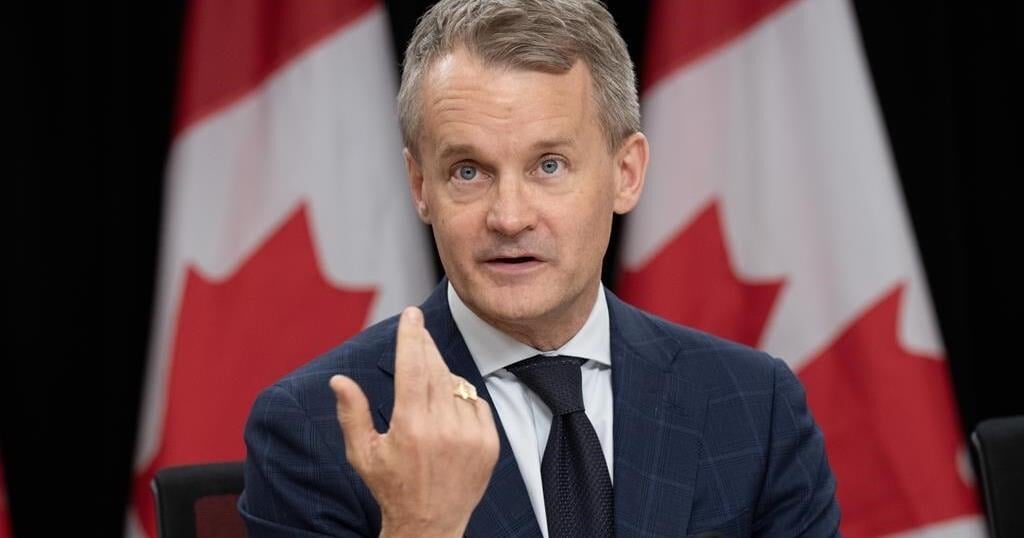OTTAWA – Labour Minister Seamus O’Regan is stepping down from cabinet and will not be seeking re-election in the next federal contest, he announced on Thursday.
A replacement for O’Regan will be sworn in at Rideau Hall on Friday, the Prime Minister’s Office said in a statement.
“The prime minister extends his sincere thanks to Minister O’Regan for his exceptional leadership and dedication to making life better for Canadians, including for unions, workers and organized labour,” the office said.
O’Regan said he would remain the MP representing the Newfoundland riding of St. John’s South-Mount Pearl until the next election, which is set to take place by fall 2025.
A source with knowledge of the matter, who would only speak under condition of anonymity, said a broader cabinet shuffle is not expected to take place.
In a statement on Thursday, O’Regan said his family comes first and he needs to be a better husband, son, uncle and friend.
“My friend Seamus has been a pragmatic voice and a relentless advocate around the cabinet table. But to do that work well, you have to sacrifice a lot, and ask so much of your family. I respect his decision whole-heartedly,” Trudeau said in a social-media post.
O’Regan had alluded to the need to spend more time with family in a speech last month in Toronto.
His father died during the COVID-19 pandemic, and he is a caregiver for his mother, who lives in St. John’s.
O’Regan told the Canadian Club Toronto crowd that he always has his phone volume turned up in case it rings and it’s his mom on the line.
“If, God forbid, something happens to mom right now in St. John’s, I’m the first one to get the call. I’m number one on her lifeline,” he said in his address.
O’Regan, 53, was elected as a member of Parliament in 2015 and has served as a minister since 2017, overseeing several portfolios including for seniors.
He took on his current portfolio in 2021 and was the federal point person on labour issues as several major strikes unfolded.
That included a national walk-out involving thousands of federal public servants last year, as well as a strike at Canada’s busiest port in Vancouver, where the movement of billions of dollars in trade stalled during an extended impasse.
As a cabinet minister, O’Regan introduced multiple government bills. Most recently, he shepherded legislation to ban replacement workers during strikes and lockouts, a New Democrat priority and the fulfilment of a decades-long push from unions.
While serving in the Indigenous services portfolio, he oversaw a bill that sought to give Indigenous groups and communities jurisdiction over child and family services.
“So much of my work in politics has been about dignity,” O’Regan said in a speech to the Canadian Club Toronto last month.
“Dignity for veterans, dignity for Indigenous Peoples, dignity for workers.”
When O’Regan was veterans affairs minister, Trudeau apologized on behalf of Canada for decades of discrimination against the LGBTQ+ community — an occasion for the minister to open up about his own identity as a gay man.
O’Regan shared that it wasn’t until after he became an MP and went through rehabilitation for alcohol addiction in late 2015 that he realized his sexuality was connected to his substance abuse.
“There’s the battle that is fought on, ‘This is my identity, this is who I am,”‘ O’Regan told The Canadian Press in 2017.
“There is also the battle of, ‘Who the hell is the government to tell me who to love? Who the hell is the government to tell me who I can’t love?'”
O’Regan was previously known to many Canadians as a journalist and for his 10 years as co-host of CTV’s Canada AM.
Before entering politics, he was already a longtime friend of Trudeau’s, having been a member of the prime minister’s wedding party when he got married in 2005.
O’Regan and his husband Stelios Doussis also travelled with Trudeau on a family vacation to the Bahamas in 2016.
On Thursday, O’Regan said he will miss working with the prime minister, who he believes “will be regarded as one of the most consequential and important leaders in our country’s history.”
Reflecting on his nine years in office, O’Regan said it’s been “hectic times,” but worthwhile.
“This is a time to unite not divide, create not destroy and build rather than break this great country of Canada,” O’Regan said. “It is a treasure. It’s worth fighting for.”
This report by The Canadian Press was first published July 18, 2024.

























